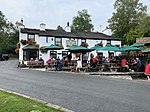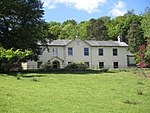Chapel Stile

Chapel Stile is a village in Cumbria, England, located approximately 5 miles northwest of Ambleside, within the Langdale valley. It contains a school, Holy Trinity church, the Co-op and the Wainwrights' Inn (formerly The Langdale Hotel), and a quarry is located in the vicinity. Couples who choose to get married at the church are traditionally 'tied in' during the service. The local children tie up the church gates and the newlyweds are only released when coins (of small denomination) are thrown to said children. The Co-op has been established for well over a hundred years. Chapel Stile also gives access to the Langdale Pikes, Pike o' Stickle and Harrison Stickle. Other notable fells nearby are Pavey Ark, Bowfell and Pike o' Blisco. Rock climbing in the area includes Raven Cragg. A worthy climbing venue and less populated than its famous counterpart further in the Langdale valley at the back of the Old Dungeon Ghyll. In popular culture, or at least 'underground popular culture', there is a nu jazz track called 'Chapel Stile' by Pretz (N.Cowley). Due to its location within a popular tourist destination, around 85% of the homes within the community are now either second homes or holiday lets.
Excerpt from the Wikipedia article Chapel Stile (License: CC BY-SA 3.0, Authors, Images).Chapel Stile
B5343,
Geographical coordinates (GPS) Address Nearby Places Show on map
Geographical coordinates (GPS)
| Latitude | Longitude |
|---|---|
| N 54.440353 ° | E -3.048434 ° |
Address
Holy Trinity Mission Chapel
B5343
LA22 9JE , Lakes
England, United Kingdom
Open on Google Maps











